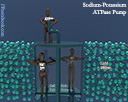Cell Physiology, Cellular Physiology, Cellular Anatomy, Cell Structure, Cell Biology
- See Also
- Mechanism
- Cell Membrane Chemical Transport
- Background
- Cellular membranes (phospholipid bilayer) are selectively permeable
- Lipid soluble substances are non-polar and may move across the cell membrane
- Charged substances (e.g. Electrolytes such as Calcium, Sodium, Potassium) move through water channels in the membrane
- Simple Diffusion
- Simple Facilitated Diffusion
- Transport Proteins (channels, carrier Proteins) allow charged particles to cross the cell membrane
- Unlike active transport, no energy is required, as the molecules are following an osmotic gradient
- Channel Proteins create a hydophilic tunnel through the hydrophobic core of the lipid bilayer
- Aquaporins allow water to rapidly cross cellular membranes
- Channels may be gated (only periodically allowing molecules to pass)
- Carrier Proteins
- Transport Proteins (channels, carrier Proteins) allow charged particles to cross the cell membrane
- Active Transport
- Molecules move against their electrochemical gradient
- Primary Active Transport
- Secondary Active Transport
- Movement against electrochemical gradient is fueled by another molecule moving WITH its electrochemical gradient
- In Cotransport, the 2 molecules move in the same direction across the cell membrane
- In Countertransport, the 2 molecules move in opposite direction across the cell membrane
- References
- Membrane Transport (Wikipedia)
